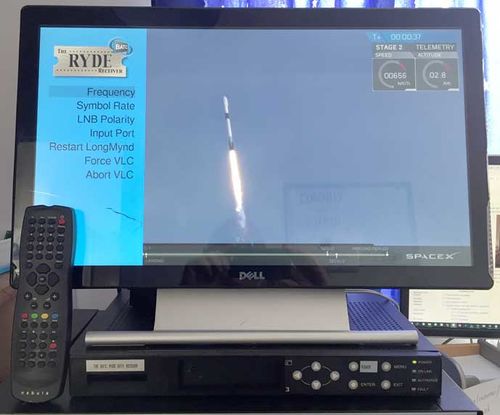Difference between revisions of "Ryde Receiver"
| Line 48: | Line 48: | ||
The Ryde has been designed to control the Portsdown 4 and 8 way RF switches https://wiki.batc.org.uk/8-Band_RF_Output_Switch The RF switch should be built leaving out the MMIC stage U10 which is bypassed with a short circuit or a 1nf capacitor. | The Ryde has been designed to control the Portsdown 4 and 8 way RF switches https://wiki.batc.org.uk/8-Band_RF_Output_Switch The RF switch should be built leaving out the MMIC stage U10 which is bypassed with a short circuit or a 1nf capacitor. | ||
| − | Note that the Raspberry Pi 4 GPIO connections are different to the Raspberry Pi 3 | + | ====GPIO connection==== |
| + | |||
| + | A GPIO breakout PCB is available from the BATC shop - NOTE, this PCB is intended to be mounted to go outside the Pi4 profile as shown above. | ||
| + | |||
| + | '''Note that the Raspberry Pi 4 GPIO connections are different to the Raspberry Pi 3''' | ||
Full details of the Ryde GPIO connections are here: [[Ryde_GPIO_Connections]] | Full details of the Ryde GPIO connections are here: [[Ryde_GPIO_Connections]] | ||
Revision as of 10:41, 2 December 2020
The BATC Ryde receiver is a stand-alone receiver or Set Top Box (STB) designed specifically for Digital Amateur TV with similar functionality to a consumer STB.
It is controlled by an IR remote and has a "point and shoot" interface - simply enter frequency and SR and the Ryde will look for DATV signals without the need to enter Bouquets, transponders or scan across a range of frequencies.
- The Ryde is a standalone receiver controlled by an infra-red remote with on-screen menus
- The Ryde directly drives an external HDMI or composite video (PAL/NTSC) monitor
- The Ryde does not require any additional hardware such as a PC
- The Ryde provides a lock indication output for use at DATV repeater sites.
Project history and status
The Ryde receiver project was conceived by G8GTZ, the requirements were published in April 2020 and first beta models were demonstrated in late June 2020 with the first development release in Mid July 2020
Ryde Hardware
The Ryde receiver is simple to construct and is built from a standard Raspberry Pi 4 and standard MiniTiouner USB receiver hardware. Full hardware details are described on this page: Ryde Hardware.
Version 1
The first version of Ryde is based around a Raspberry Pi 4 and the BATC MiniTiouner V2 PCB connected via USB. It is intended that the software will continue to support this version even after version 2 hardware is released.
The above shows the four of the main parts of the Ryde Version 1:-
1. Raspberry Pi 4
2. GPIO breakout PCB
3. 12V input 5.2V 5A output DC to DC converter
4. Switch and IR sensor PCB
All parts are mounted in a Eddystone 26827PSLA Diecast box (Farnell Ordercode 301589) with room for future expansion. The BATC MiniTiouner is mounted in a separate box connected by USB to the Raspberry Pi.
Version 2
A single PCB is in development removing the need for the USB interface. This will be a standalone alone unit with the RPi mounted on the motherboard but will require users to buy a complete new set of components including Serit tuner.
IR remote control
More details on how to connect an IR sensor to the Ryde, which remote control to use and how to program your own control are here: Ryde remote controls
RF input band switching
The Ryde has been designed to control the Portsdown 4 and 8 way RF switches https://wiki.batc.org.uk/8-Band_RF_Output_Switch The RF switch should be built leaving out the MMIC stage U10 which is bypassed with a short circuit or a 1nf capacitor.
GPIO connection
A GPIO breakout PCB is available from the BATC shop - NOTE, this PCB is intended to be mounted to go outside the Pi4 profile as shown above.
Note that the Raspberry Pi 4 GPIO connections are different to the Raspberry Pi 3
Full details of the Ryde GPIO connections are here: Ryde_GPIO_Connections
Ryde Software
There are 2 ways to get the Ryde Software. As with Portsdown, you can buy a pre-programmed SD Card from the BATC Shop; or you can build your own card by following the instructions here: BATC GitHub Ryde Build Page. The process will be familiar to anyone who has built a Portsdown SD Card.
Once you have bought or built your card, please read this information about using the Ryde Software.
The Ryde as a Repeater Receiver
As well as a dedicated shack receiver without the need for a PC, the Ryde is also designed for use at repeater sites. Features in the requirement specification include the following (all subject to feasibility and commitment by development team volunteers):
- Reliable lock indicator output from the RPi GPIO connector.
- Status banner showing station ID, MER and D number displayed after signal lock (Display period adjustable in config menu)
- Status banner displayed when GPIO port triggered (can be triggered by external DTMF detector etc)
- Symbol rate search across a number of presets. Feature would enable a single Ryde receiver to listen on 437MHz and receive 2Ms, 1Ms, 333ks and 125ks signals
FAQ
If you are having problems with your Ryde Receiver, please check these FAQs before posting any questions on the BATC Forum. Ryde FAQ
Original Requirement Specification
The original requirement specification for the Ryde Receiver, written in April 2020 by G8GTZ, can be found here: Ryde Requirement Specification.

